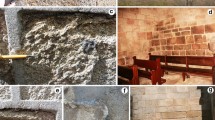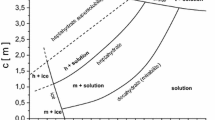Abstract
The influence of pore structure, water transport properties and rock strength on salt weathering is evaluated by means of a thorough rock characterisation and a statistical analysis. The pore structure was described in terms of its porosity, pore size distribution (quantified by mean pore radius) and specific surface area, density and water transport was characterised by means of water permeability (saturated flow) and capillary imbibition (unsaturated flow); whilst the rock strength test was carried out using uniaxial compressive strength, compressional and shear wave velocities, dynamic elastic constants and waveform energy and attenuation were obtained from the digital analysis of the transmitted signal. A principal component analysis and a stepwise multiple regression model was carried out in order to examine the direct relationships between salt weathering and petrophysical properties. From the principal component analysis, two main components were obtained and assigned a petrophysical meaning. The first component is mostly linked to mechanical properties, porosity and density whereas the second component is associated with the water transport and pore structure. Salt weathering, quantified by the percentage of weight loss after salt crystallisation, was included in both principal components, showing its dependence on their petrophysical properties. The stepwise multiple regression analysis found that rock strength has a predominant statistical weight in the prediction of salt weathering, with a minor contribution of water transport and pore structure parameters.




Similar content being viewed by others
References
Anon (1999) Métodos de ensayo para piedra natural. Determinación de la resistencia a la compresión. UNE-EN 1926
Bear J (1988) Dynamics of fluids in porous media. Elsevier, New York
Bell FG (2000) Engineering properties of soils and rocks. Blackwell, Oxford
Benavente D (2003) Modelización y estimación de la durabilidad de materiales pétreos porosos frente a la cristalización de sales. Biblioteca Virtual Miguel de Cervantes. http://www.cervantesvirtual.com/FichaObra.html?Ref=12011 (accessed on 15/06/2006)
Benavente D, García del Cura MA, Bernabéu A, Ordóñez S (2001) Quantification of salt weathering in porous stones using an experimental continuos partial immersion method. Eng Geol 59:313–325
Benavente D, Lock P, García del Cura MA, Ordóñez S (2002) Predicting the capillary imbibition of porous rocks from microstructure. Trans Porous Media 49:59–76
Benavente D, García del Cura MA, Fort R, Ordóñez S (2004) Durability estimation of porous building stones from pore structure and strength. Eng Geol 74:113–127
Benavente D, Martínez-Martínez J, Jáuregui P, Rodríguez MA, García del Cura MA (2006) Assessment of the strength of building rocks using signal processing procedures. Constr Build Mater 20:562–568
Bourbié T, Zinszner B (1985) Hydraulic and acoustic properties as a function of porosity in Fontainebleau sandstone. J Geophys Res 90:11524–11532
Christensen NI (1990) Seismic velocities. In: Carmichael RS (eds) Practical handbook of physical properties of rocks and minerals, CRC Press, Boca Raton pp 429–546
Doyen PM (1988) Permeability, conductivity, and pore geometry of sandstone. J Geophys Res 93:7729–7740
Dullien FAL (1992) Porous media fluid transport and pore structure. Academic Press, San Diego
Everett DH (1961) Thermodynamics of frost damage to porous solids. Trans Faraday Soc 57(9):1541
Goudie AS (1999) Experimental salt weathering of limestone in relation to rock properties. Earth Surf Process Landforms 24:715–724
Gregg SJ, Sing KSW (1982) Adsorption, surface area, and porosity, 2nd edn. Academic Press, London
Guéguen Y, Palciauskas V (1994) Introduction to the physics of rock. Princeton University Press, Princeton
Jiménez González I, Scherer GW (2004) Effect of swelling inhibitors on the swelling and stress relaxation of clay bearing stones. Environ Geol 46:364–377
Mosquera MJ, Rivas T, Prieto B, Silva B (2000) Capillary rise in granitic rocks: interpretation of kinetics on the basis of pore structure. J Colloid Interface Sci 222:41–45
Nicholson DT (2001) Pore properties as indicators of breakdown mechanisms in experimentally weathered limestones. Earth Surf Process Landforms 26:819–838
Rouquerol J, Avnir D, Fairbridge CW, Everett DH, Haynes JH, Pernicone N, Ramsay JDF, Sing KSW, Unger KK (1994) Recommendations for the characterization of porous solids. Pure Appl Chem 66:1739–1758
Scherer GW (2004) Stress from crystallisation of salt. Cement Concrete Res 34:1613–1624
Scherer GW, Flatt R, Wheeler G (2001) Materials science research for the conservation of sculpture and monuments. MRS Bull 26:44–50
Schön JH (1996) Physical properties of rocks: fundamentals and principles of petrophysics. Handbook of geophysical exploration. Section I, Seismic exploration, vol. 18. Pergamon, New York
Steiger M (2005) Crystal growth in porous materials—II: influence of crystal size on the crystallization pressure. J Cryst Growth 282:470–481
Tiab D, Donaldson EC (1996) Petrophysics: theory and practice of measuring reservoir rock and fluid transport properties. Gulf Publishing Company, Houston
Valdeón L, de Freitas MH, King MS (1996) Assessment of the quality of building stones using signal processing procedures. Q J Eng Geol 29:299–308
Washburn EW (1921) The dynamics of capillary flow. Phys Rev 17:273–283
Winkler EM (1997) Stone in architecture: properties, durability, 3rd edn. Springer, Berlin Heidelberg New York
Wong PZ, Koplik J, Tomanic JP (1984) Conductivity and permeability of rocks. Phys Rev B 30:6606–6614
Zimmerman RW, Bodvarsson G (1991) A simple approximate solution for horizontal infiltration in a Brooks–Corey medium. Trans Porous Media 6:195–205
Acknowledgments
This study was financed by the Generalitat Valenciana (Spain) through the Research Project GV05/129 and Research Group 03/158.
Author information
Authors and Affiliations
Corresponding author
Rights and permissions
About this article
Cite this article
Benavente, D., Cueto, N., Martínez-Martínez, J. et al. The influence of petrophysical properties on the salt weathering of porous building rocks. Environ Geol 52, 215–224 (2007). https://doi.org/10.1007/s00254-006-0475-y
Received:
Accepted:
Published:
Issue Date:
DOI: https://doi.org/10.1007/s00254-006-0475-y




